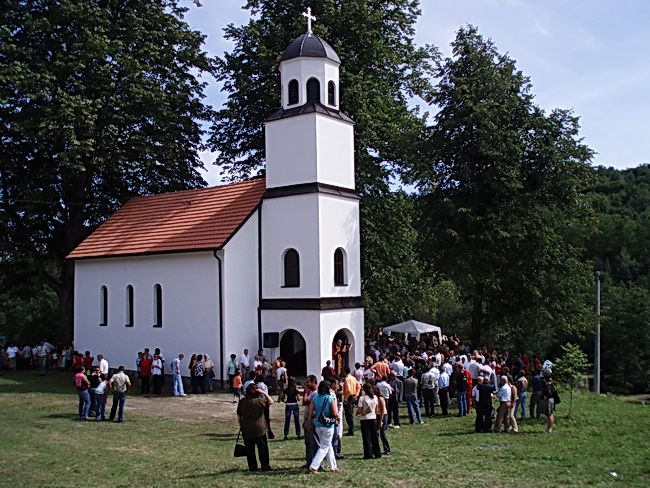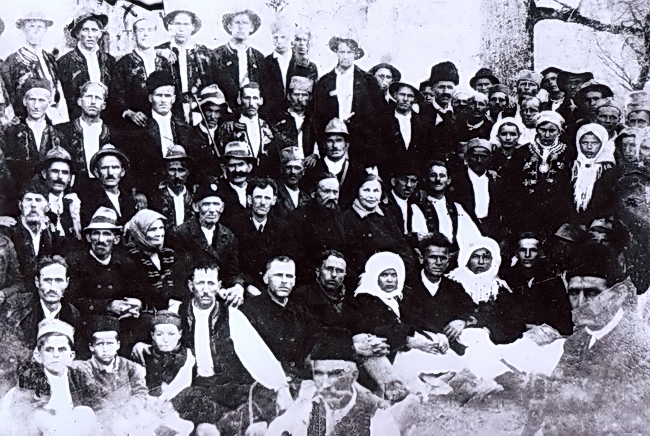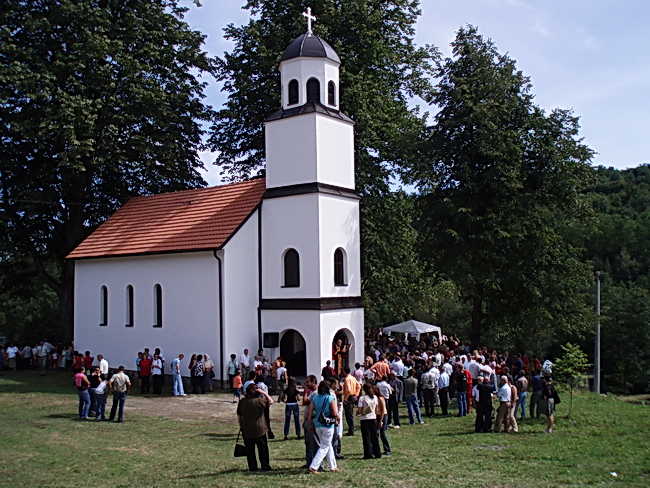
SKIPOVAC – GENERAL DATA
Skipovac is a village on Mount Trebava which was in 1937 divided, both in the https://jadovno.com/wp-content/uploads/2010/02/13-1.jpgistrative and territorial sense, into two villages: Gornji (upper) and Donji (lower) Skipovac. Mount Trebava in a narrow sense consists of around twenty villages – from the River Spreča and Stanić-Rijeka to the Duga Njiva above Modriča (from the northeast side) and from Kostajnica to Modriča from the western side (the Bosna River valley). Trebava is mostly populated by Orthodox Christians. Trebava, just as Mount Ozren, has been populated, throughout the long history of colonisation, by people from all ends of this part of the Balkans: Serbia, Raška, Montenegro, Herzegovina, Bosnian Krajina, and many families also from Ozren moved there. That is why the legends and customs from Ozren and Trebava are virtually the same, just as the mental and spiritual heritage.
Skipovac is located 12.5 kilometres north from Gračanica. At the north it borders with Zelinja, on the west and southwest with Lukavica, on the east with Prijeko Brdo and on the northeast with Međeđa.
The altitude is from 308 to 694 metres. The climate is moderate continental and in the geomorphological sense the terrain are rolling hills carved by small streams and little rivers.
In the hydrographical sense, the Skipovac area is rich with springs of various sizes, which produce small streams and little rivers. This is the area where the Javorinski Stream, Kostića Stream, Kadijevac and others spring out. Somewhat larger are the Lukavička River, Jelova River and Cjetovlja (on maps marked as the Cjetovija). Both of these natural watercourses are formed in the area of Gornji Skipovac, which is a watershed between the rivers Bosna and Tinja.
PROCLAMATION OF THE NDH IN 1941.
In Zagreb, on April 10, the Independent State of Croatia was proclaimed. This ceremony was attended by a special German envoy Edmund Wesemayer, and the proclamation was blessed by the Vatican and the first Croatian politician Vlatko Maček.
The similar process was going on in the neighbouring Slovenia. Dravska Banovina Governor Dr. Marko Natlačen formed the National Council out of representatives of political parties and on April 10 proclaimed the independent state, which was to join the Triple Alliance.
Under the proclaimed motto „one third of Serbs to be converted into Catholicism, one third expelled and one third killed“, Ustasha leaders headed by Poglavnik Ante Pavelić started their bloody work. In order to exterminate the Serbs as quickly as possible, the Ustashas established concentration camps in Gospić (Jadovno and Slana on Pag), Jastrebarsko, Gradiška and Jasenovac which were „functioning unhindered“ throughout the war, regardless of the proximity of Partisan and Chetnik rebel units.
The Serbian people were met with difficult days, filled with fear and uncertainty. Yugoslavia had been overrun, the army had been smashed, and over 30,000 officers and soldiers had been taken to Germany as prisoners of war. A part of non-Serb officers and soldiers were released home. They mostly joined quisling units, while troops of Serbian ethnicity remained in work camps until the capitulation of Germany, far away from their homeland. In that way they were not able to defend their country and protect their families, who so undefended became an easy „prey“ to the Ustasha butchers.
The mass Ustasha terror started immediately in May and June 1941 in East Herzegovina, East Bosnia, Lika, Kordun, Banija, Western Slavonia, Bosnian Krajina, and in central and northern parts of Bosnia. They first started the deportation of priests, teachers, members of the „Sokoli“ (Hawks), and then all other distinguished Serbs from all parts of the established NDH.
GRAČANICA AND THE SURROUNDING AREA IN 1941.
During the Second World War, a true spiritual genocide was committed in the area of the Zvornik and Tuzla Eparchy. 36 priests and two monks were savagely murdered. During the war, 17 Orthodox temples were destroyed and 37 were damaged. One monastery and 25 parish homes were destroyed (10 by explosives and 15 by burning). Along with these, another 20 various Church facilities were damaged. 62 church archives were destroyed and 49 church and monastery libraries disappeared forever.
There was a plan to displace 28 families with 100 members from the Gračanica Canton. This task was entrusted to and performed by Franjo Šajkaš, Deputy District Chief. He got he information on the properties from the Reconstruction Office. Five priest were one of the first to be displaced in June 1941: Mitar Sofrenović, Dejan
Vujasinović, a priest from Skipovac, and two priests from the St. Nicolas Monastery, Abbot Gavrilo Vukojev and priest Jovo Ljubojević. The others were displaced later. The transport of these families started in mid-August 1941, and it ended with the rebellion on Ozren on August 23, 1941, so the families from Kakmuže and Petrovo Selo were not displaced, although there had been a plan for that.
The displaced Serbian families from Gračanica were the families of Vladimir and Dušan Simeunović, Luka Nešković, Stanko Trifković, Stanko Ivanišević, Jovo Blagojević, Branko Nikolić, Ranko Arnautović and Dimitrije Jovanović. From Ozren and Boljanić displaced were families of Savo Janković, Jovan Janković, Todok Lukić, Đuro Vukeljić, Tripo Kitić. Also displaced were: from Karanovac the family of Pero Žižak, from Sočkovac of Risto Lazarević with his wife Mara, son Danko and daughter Trivuna. The displaced families were transported in trains. The Croatian authorities populated their houses with people from Slovenia.
SKIPOVAC 1941. – 1945.
In the Second World War, Skipovac suffered many things, at the beginning of the war by the NDH occupational forces, and at the end of the war by the 16th Muslim Partisan Brigade. In fall 1944, the SS troops from the 13th
SS „Handzar“ Division (who had been soaked with Serbian blood throughout the war) en masse moved to the 16th Muslim Partisan Brigade and the Tuzla Partisan Detachment.
Members of the 16th Muslim Partisan Brigade, on August 17, 1945, in various ways killed 42 persons in villages Donji and Gornji Skipovac. They were mostly shepherds, people ploughing the fields, 18 of them young men from age 17 to 18.

THE LIST OF PEOPLE KILLED IN SKIPOVAC DURING THE
SECOND WORLD WAR FROM 1941. TO 1947.
VILLAGE GORNJI SKIPOVAC
Chetniks, Partisans and civilians killed by Ustashas and Germans:
1.Ilija Andrić
2.Mojsija Gavrić
3.Savo Andrić
4.Kojo (son of Petar) Tešić
5.Stevo (son of Petar) Tešić
6.Trivo (son of Mitar) Tešić
7.Luka (son of Jefrem) Ilić
8.Mojsija (son of Jefrem) Ilić
9.Pero (son of Đokan) Ilić
10.Milan (son of Stefan) Ilić
11.Sofren (son of Tripun) Ilić
12.Jovan (son of Đorđe) Ristić
13.Kojo (son of Pero) Ristić
14.Obrad (son of Stjepan) Čolić
15.Rado (son of Stjepan) Čolić
16.Konstantin (son of Simo) Tomić
17.Jovo Vasiljević
18.Petar (son of Božo) Topalović
19.Markan (son of Simeun) Topalović
20.Vasilija (daughter of Jovan) Topalović
21.Vaskrsija (son of Nikola) Topalović
22.Nikola (son of Risto) Topalović
23.Cvijan (son of Risto) Topalović
24.Blagoje Đuranović
25.Simo (son of Cvijan) Stijepić
26.Savo (son of Mitar) Tešić
27.Jovo Savić
28.Peće Relja teacher
29.Mićo (son of Ljubo) Mičić
30.Gavro (son of Pavle) Jović
31.Marija (daughter of Konstantin) Tomić
Chetniks and civilians killed by partisans:
1.Krsta (daughter of Petar) Stefanović
2.Stevan (son of Petar) Stefanović
3.Andrija (son of Nikola) Andrić
4.Luka (son of Živko) Lukić
5.Živko (son of Spasoje) Lukić
6.Radoslav (son of Obrad) Gavrić
7.Milan (son of Mojsije) Gavrić
8.Vaso (son of Luka) Todorović
9.Vid (son of Luka) Todorović
10.Ranko (son of Mitar) Tešić
11.Petar (son of Mitar) Tešić
12.Rajko (son of Spasoje) Topalović
13.Lazar (son of Luka) Topalović
14.Krsta (daughter of Božo) Topalović
15.Ignjatija (daughter of Mihajlo) Topalović
16.Marko (son of Miladin) Ristić
17.Mitar (son of Jovan) Ristić
18.Andrija (son of Luka) Ilić
19.Nedeljko (son of Đuro) Tešić
20.Stjepan (son of Risto) Ristić
21.Milo (son of Milanko) Božić
22.Božo (son of Boško) Božić
23.Stevo (son of Pero) Stijepić
24.Dragoljub (son of Risto) Suvajac
25.Stjepan (son of Obrad) Čolić
26.Milan Jakovljević
27.Priest Aleksandar Blekovski (Russian)
Partisans and civilians killed by Chetniks:
1.Kojo (son of Nikola) Božić
VILLAGE DONJI SKIPOVAC
Chetniks, Partisans and civilians killed by Ustashas and Germans:
1.Janko Janković
2.Čedo (son of Đuro) Spasojević
3.Vaskrsija Puranović
4.Savo (son of Pero) Savić
5.Mihailo (son of Pero) Savić
6.Risto (son of Stanko) Vasiljević
7.Nikola Kojić
8.Vladislav Janković
Chetniks and civilians killed by partisans:
1.Pero Stanković
2.Miloš (son of Mitar) Tičić
3.Mitar (son of Mitar) Tičić
4.Svetozar (son of Pero) Stanković
5.Stefan Todorović
6.Marko (son of Cvika) Todorović
7.Dušan (son of Obrad) Stanković
8.Živan (son of Obrad) Todorović
9.Stevo (son of Stanko) Kojić
10.Živko (son of Milivoj) Novaković
11.Božo Bijelović
12.Sofren (son of Stojan) Kostić
13.Dušan (son of Blago) Pavlović
14.Simeun (son of Čedo) Vasić
15.Savo (son of Trivko) Vasić
16.Boro (son of Boško) Kostić
17.Čedo (son of Nedeljko) Vasić
18.Nikola (son of Stojan) Lazarević
19.Todor (son of Luka) Bjelkić
20.Mihajlo (son of Stojan) Lazarević
21.Dušan (son of Miroslav) Jovičić
22.Cvjetko (son of Blago) Kostić
23.Jovan (son of Rade) Blagojević
24.Niko Sarić
25.Jovan (son of Rade) Blagojević
26.Niko Sarić
27.Radoslav (son of Obrad) Gavrić
Partisans and civilians killed by Chetniks:
1.Rajko (son of Mitar) Vasić
2.Pero (son of Mitar) Vasić
3.Rajko Sarić
4.Milica Todorović
5.Dragan (son of Gojko) Momić
THE LIST OF HOUSES BURNED DOWN BY PARTISANS IN THE SECOND WORLD WAR
1. Petar Topalović, burned by Partisans
2. Đokan Topalović, burned by Partisans
3. Tomo Savić, burned by Partisans
SOURCES:
1.http://www.spc.rs/Genocid/Zvornicko/zvornickol.html
2.
13th_Waffen_Mountain_Division_of_the_SS_Handschar_(1st_Croatian)
3. Maksimović, Milenko: Immortals of Ozren, Trebava and Posavina/ Milenko Maksimović – revised and amended edition – Doboj: Press and Publishing Štampa. 2002 (Beograd: „BIG štampa). 552 pages: photo 24cm – „Svitanja Edition“
4. Monography: Bora Topalović: One Hundred and Ten Years of the Skipovac Primary School, 1875 – 1985, Belgrade 1985.

